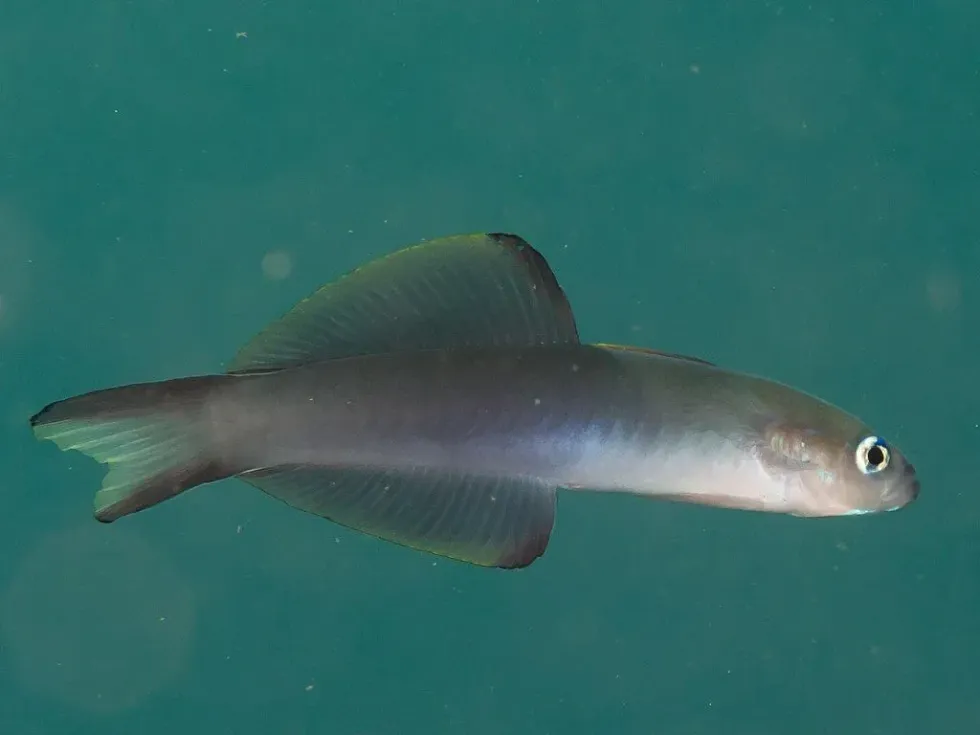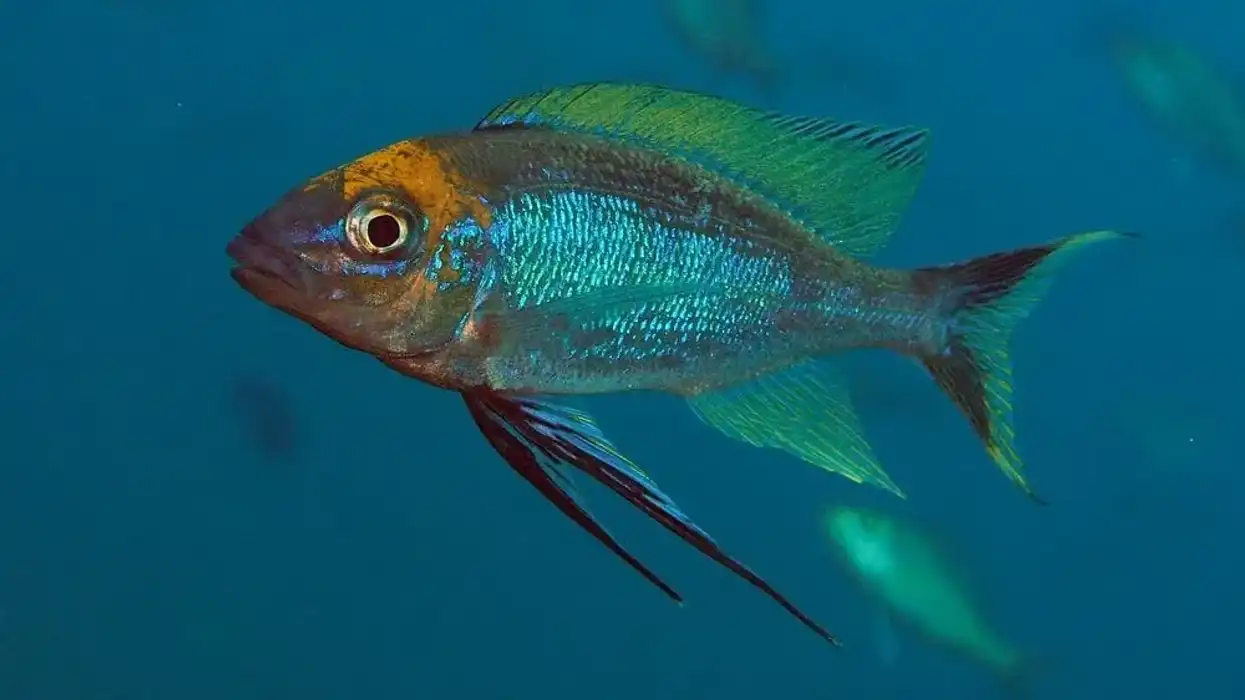Blackfin dartfish (Ptereleotris evides) are usually known and recognized by their unique special torpedo-like body shape belonging to the family Gobiidae, with classification order of Gobiiformes. They are reef safe and have plenty of personality.
The distribution of this fish is mainly in the Indo-Pacific, the Red Sea, and East Africa to the Line and Society islands, north to the Ryukyu and Ogasawara islands, south to New South Wales, Lord Howe Island, and Rapa. These species of scissortail dartfish find places to hide when feeling threatened by other large and aggressive fishes or whales.
In the ocean, they can be found in medium-depth water. These fish are not endangered, since their population is stable.
This fish is related to Helfrich's dartfish physically, but not in coloration wise.
When these fish hide they are not able to feed and they can die due to a shortage of food, One has, therefore, a greater chance of success when they live with small size, peaceful fish and then dim the light of the tank to provide them some peace.
Most of their time is utilized in water cruising for food rather than retreating to their burrow like other fish in this genus. A moderate current should be made in an aquarium as the blackfin dartfish is an Aquarium Industries recommended 'must have' for any marine tank or aquarium.
Those raised in tanks or aquariums must be provided with proper care.
If you liked blackfin dartfish, you may also want to check out Arctic char facts and Monkfish facts.
Blackfin Dartfish Interesting Facts
What type of animal is a blackfin dartfish?
The blackfin dartfish, Ptereleotris evides, is a type of dartfish species.
What class of animal does a blackfin dartfish belong to?
The blackfin dartfish (Ptereleotris evides) belongs to the class Actinopterygii and the phylum Chordata.
How many blackfin dartfish are there in the world?
The total number of blackfin dartfish present in the world is unidentified.
Where does a blackfin dartfish live?
The blackfin dartfish lives in the ocean. They prefer areas covered with sand and should be surrounded by rocks and coral. One can provide them with ready-made burrows made out of plastic piping strategically placed for them to discover.
What is a blackfin dartfish's habitat?
They can be found at depth of 6.5-49.2 ft (2-15 m). They are usually found in the East Indian Ocean, West Indian Ocean, Australia, Japan, The Red Sea, Indonesia, East Pacific, West Pacific.
The Indo-Pacific region is its natural range. They are also known as aquarium fish. Blackfin dartfish habitats usually comprise rooms with ample swimming space as well as aquariums with low temperatures.
Who do blackfin dartfish live with?
They can be kept as a single individual or a pair and even in groups. If someone wants to keep them they should buy the pair as an individual, fish may fight.
How long does a blackfin dartfish live?
The average lifespan of a Ptereleotris evides is 8-10 years in general.
How do they reproduce?
During the breeding process, they seem to form monogamous pairs. Keeping the information in order they keep eggs in a burrow. Monogamous mating is observed as both are obligate, social, and peaceful fishes. This process lasts mainly from March to May.
What is their conservation status?
The conservation status of Ptereleotris evides is of Least Concern as their population is stable.
Blackfin Dartfish Fun Facts
What do blackfin dartfish look like?

The blackfin dartfish has subtle colorations of silvery/blue, gray to black towards the anal fin which keeping splits in color to form a scissor shape, giving rise to another of its common names, the scissortail goby.
This peaceful fish spends its days burrowing into sand searching for food, particularly brine and Mysis shrimp.
commonly found hovering on sandy areas of the reef. These are very popular in a community reef aquarium, light yellow dorsal fin is used to communicate to each other and sometimes flicked up and down.
It has a white head and blue body with a large dorsal and anal fin the coloration of their caudal fin is very dark on both sides, while it remains transparent in the middle section.
Caudal fin lobes are blackish to dark red, their dorsal fin is a dull orange, anal fins largely blackish pectoral base with a red bar edged in blue.
Juveniles with an oval black spot larger than the eye at the lower base of the caudal fin, and according to the classification of care sheet, its length is up to 5.5 in (14 cm) and they weigh around 330.6 lb (150 kg).
How cute are they?
These species are so cute, modest, and easy to care for marine water fish and best to keep as pair in an aquarium or fish tank. They are quite shy in nature, which makes them adorable.
How do they communicate?
The bright yellow dorsal fin is used to communicate to other family members and sometimes flicked up and down.
How big is a blackfin dartfish?
The length of this fish is around 5.5 in (14 cm) and it's 7 times large than a normal ocean fish.
How fast can a blackfin dartfish swim?
They are so quick at their movements to grab their food and swim so fast cutting the ocean water.
How much does a blackfin dartfish weigh?
The exact weight of these fish is not known, though they are very small so it is safe to say they don't weigh much!
What are the male and female names of the species?
There are no sex-specific names for blackfin dartfish.
What would you call a baby blackfin dartfish?
The common name of a baby blackfin dartfish is a fry.
What do they eat?
The blackfin dartfish diet consists of zooplankton, marine food, brine shrimp. These species have an active metabolism that's why distribution by aquarium industries to feed them should be a minimum amount at a time but at least twice a day.
Are they dangerous?
Based on their special personality they are not so dangerous moreover they swim away from danger.
Would they make a good pet?
The blackfin dartfish can make a good pet as it's also kept in an aquarium. These are peaceful, social species with a shy nature. One may think of dartfish as a pet as they are an attractive and hardy species. At last based on their special appearance cute small fins with black edging.
Did you know...
Juveniles are found in small aggregations based on the distribution, both parents are close to eggs.
What adaptations do blackfin dartfish have?
Blackfin dartfish adaptation is very close to water bodies like oceans.
Are blackfin dartfish endangered?
No, their conservation status is of Least Concern, so they are not endangered.
Here at Kidadl, we have carefully created lots of interesting family-friendly animal facts for everyone to discover! Learn more about some other fish from our gar facts and koi facts pages.
You can even occupy yourself at home by coloring in one of our free printable blackfin dartfish coloring pages.









